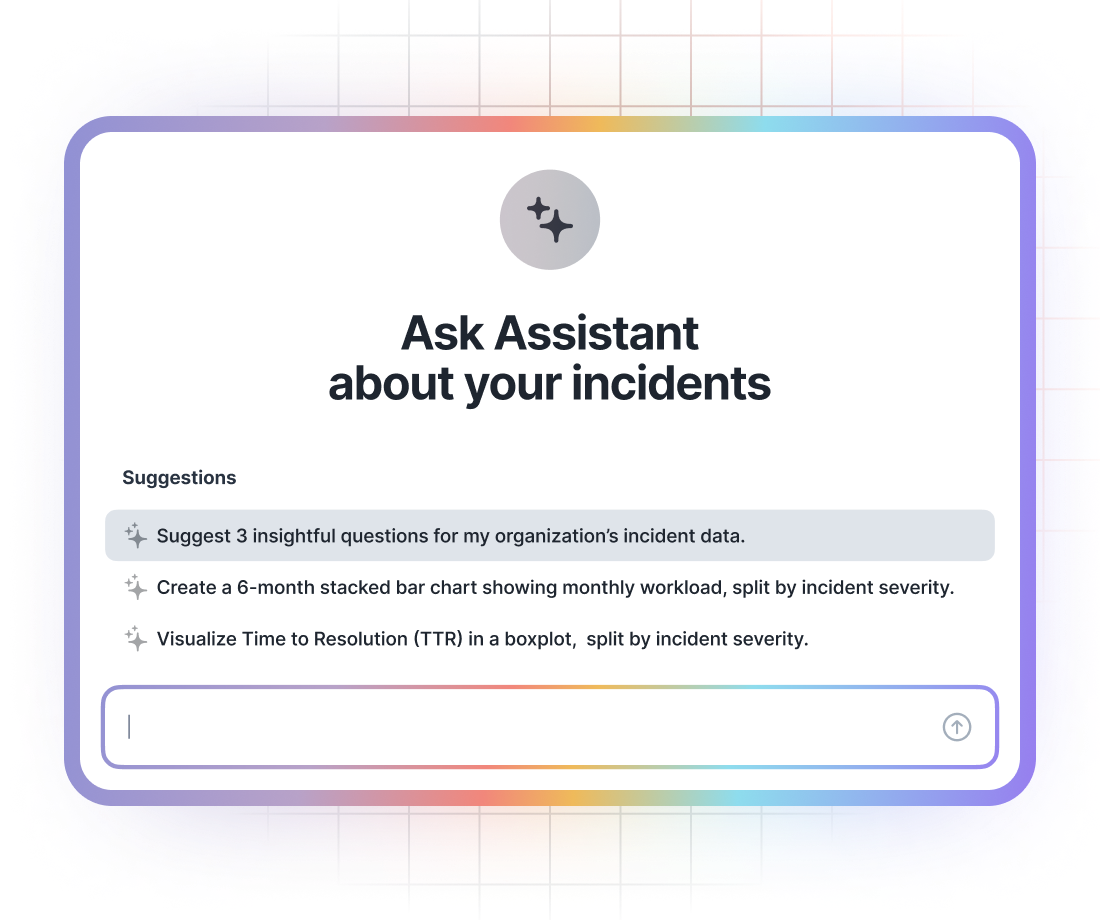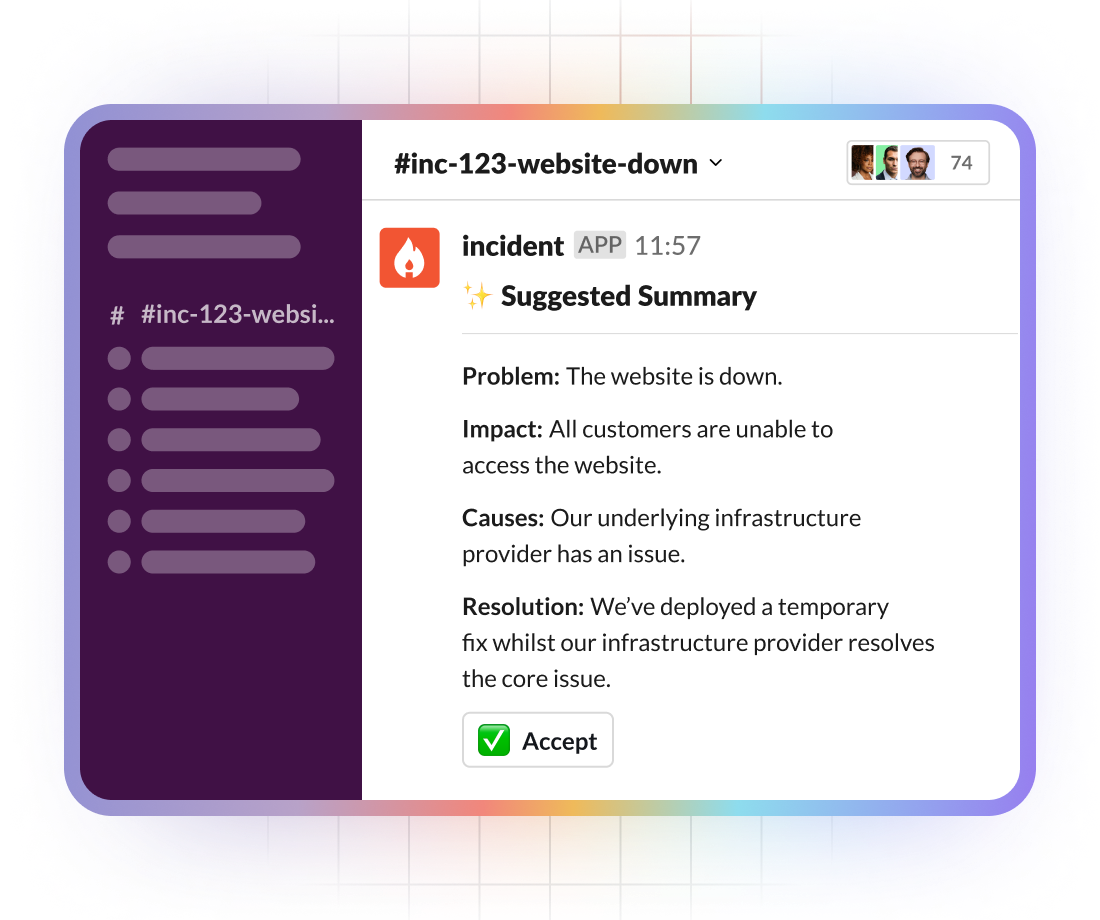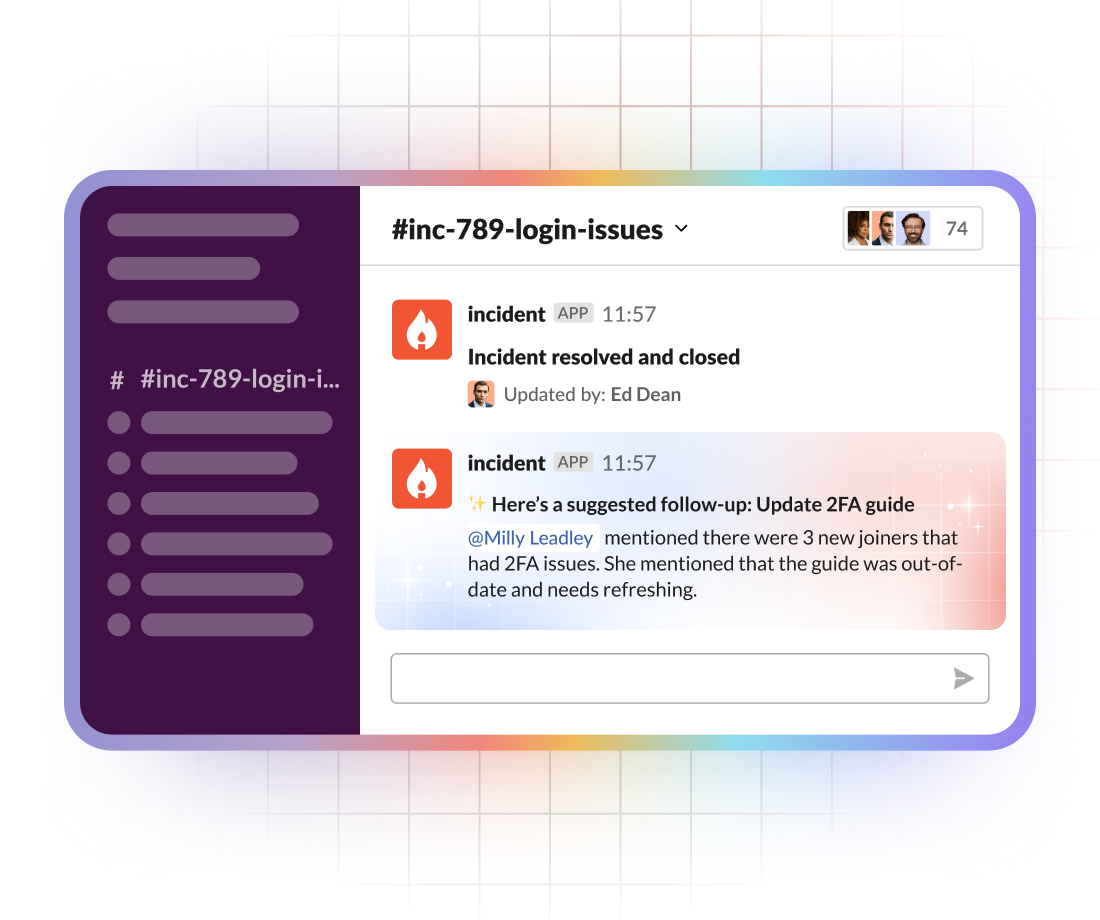Supercharged with AI

One of the most painful parts of incident management is keeping on top of the many things that happen when you’re right in the middle of an incident. From figuring out and communicating what’s happening, to ensuring you learn from previous incidents, and even capturing the right actions – incidents are hard, but they don’t need to be this hard.
Over the past few years, we’ve heard from our customers time-and-time again things like:
- How do I quickly figure out what’s happening in this incident?
- How can I respond faster if we’ve already fixed an issue like this before?
- How can I be sure I didn’t miss key information or improvement suggestions in a noisy incident channel?
Today, we’re launching a series of AI-powered features to address exactly these challenges, enabling incident responders to save crucial time, learn from previous incidents and become more resilient over time. Let’s dive in!
We're building exoskeletons — not robots
AI is often synonymous with “automation”, or the ability for computers to perform tasks that usually require human intelligence.
When figuring out what AI features we wanted to build, we saw very little pull from our customers to automate actions on their behalf — and rightly so. Incidents can be intricate and often need a well-versed incident commander to guide them to a successful conclusion.
See how we're transforming the way you learn from incidents with AI
We wanted to keep humans at the forefront of every decision, enabling them to save responder time and cognitive overhead, but not remove them from the loop. Our philosophy is that we're building exoskeletons — not robots.
So, what have you actually built?
We’re excited to announce four exciting AI-powered features to level up incident response.
🤖 Assistant
Assistant allows you to explore and learn from your incident history using natural language. You can ask free-form questions, and gain insights that were previously not possible. Whether you're aiming to create custom reports, or identify patterns over time, Assistant is here to help!
If you’re an existing customer, it’s already enabled in your account — try it out now.
If you'd like to learn more about how we built Assistant, read this blog post by one of our Product Engineers, Teddy Necsoiu.

✍️ Suggested summaries
It’s helpful for all incidents to have a summary – this allows newcomers and followers to quickly understand what’s happening at a glance. But keeping the summary up-to-date throughout the incident is tough and often forgotten about in the heat of the incident.
Now, when you provide an incident update, we’ll automatically propose a new summary for you to approve or edit. Save time, whilst staying in full control of your comms.
If you're interested in our journey building suggested summaries, read this blog post by Milly Leadley, one of our Product Engineers.

👯 Related incidents
One of the most effective ways to respond to an incident is by leaning on past experiences and expertise. But finding similar incidents takes precious time that you simply don’t have when everything’s on fire.
With related incidents, we’ll find past incidents that look similar to the current one by understanding the context, the people and involved, and the steps taken to resolve.
By automatically identifying these relationships, you can very quickly access useful context, insights, or previous actions to manage the current situation effectively.
For a behind the scenes look into how we built related incidents, read this blog post from Rob Liddle, a Product Engineer at incident.io.

🧹 Suggested follow-ups
In the midst of your response, it’s common for responders to identify the next steps to reduce the likelihood of recurrence or lessen the future impact.
When an incident is closed, we can now recommend action items by reviewing the incident channel and identifying potential follow-up points. We then cross-check these with existing action items, enabling you to more easily ensure no follow-up is left behind.

What are customers saying?
Adding AI capabilities to products has seen mixed results and like many of you, we were slightly sceptical at the outset. However, after prototyping and testing with customers over the last few months from beta testers, we genuinely believe these AI-powered features change the incident management experience for the better.
And, luckily for us, it’s not just us saying that. We’ve had countless customers building these features with us and the early results are extremely promising.
Don’t take our word for it, though! Here are just a few examples from the hundreds of pieces of feedback we’ve received since releasing this to customers:
At the end of each year I prepare a rundown of interesting observations from our incident data. This year AI Insights helped me achieve all this without the need for exporting data and playing with spreadsheets as well as bringing up new insights.
— John Paris, Skyscanner, an early partner for building Assistant
The added AI component is phenomenal and has drastically helped us by providing almost perfect summaries, unifying formats and reducing overhead for our Incident Commanders. Feedback from people involved in Incidents has been great and this feature is very much loved so far.
— Marc van Niekerk, Checkatrade after experiencing suggested summaries
They're super great-- I'm surprised at how topical they are. It feels like having an extra IC4 level engineer around to collect and document post-mortem items.
— Cerek Hillen, Ramp, taking advantage of suggested follow-ups
We honestly couldn’t be happier with how our customers have received everything so far, and we’re excited to build on this momentum. We’re just getting started!
Great, now what?
If you’re a customer, it’s likely you already have access to these AI-powered features already. We’ve been slowly rolling out over the past few weeks, and we’re now ready to release them to everyone.
Excited about what you’re reading and want to learn more about using incident.io for the first time? Get in touch with us on our website - one of our team will happily give you a tour of everything above and more.
To learn more about how we run AI projects at incident.io, you can read this blog post written by Aaron Sheah, one of our Technical Leads.
Finally, if you have any feedback, we’d love to hear from you. Drop us a message in your customer channel, reach out to @incident_io on X, or tell us what you think on LinkedIn.
Now, over to you. We hope you enjoy supercharging your incident.io experience with AI!
